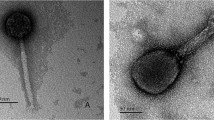Abstract
Six bacteriophages with an elongated head and a short, noncontractile tail were compared by DNA-DNA hybridization, seroneutralization kinetics, mol% G+C and molecular weight of DNA, and host range. Three phage “species” could be identified. Phage species 1 containedEnterobacter sakazakii phage C2,Erwinia herbicola phages E3 and E16P, andSalmonella newport phage 7–11. These phages had a rather wide host range (4 to 13 bacterial species). DNA relatedness among species 1 phages was above 75% relative binding ratio (S1 nuclease method, 60°C) when labeled DNA from phage C2 was used, and above 41% when labeled DNA from phage E3 was used. Molecular weight of DNA was about 58×106 (C2) to 67 ×106 (E3). The mol% G+C of DNA was 43–45. Anti-C2 serum that neutralizes all phages of species 1 does not neutralize phages of the other two species. Species 2 contains only coliphage Esc-7-11, whose host range was only oneEscherichia coli strain out of 188 strains of Enterobacteriaceae studied; it was unrelated to the other two species by seroneutralization and DNA hybridization. DNA from phage Esc-7-11 had a base composition of 43 mol% G+C and a molecular weight of about 45×106. Species 3 contains onlyProteus mirabilis phage 13/3a. Its host range was limited to swarmingProteus species. Species 3 was unrelated to the other two species by seroneutralization and DNA hybridization. DNA from phage 13/3a had a base composition of 35 mol% G+C and molecular weight of about 53×106. It is proposed that phage species be defined as phage nucleic acid hybridization groups.
Similar content being viewed by others
Literature Cited
Ackermann, H.-W. 1976. La classification des phages caudés des Entérobactéries. Pathologie et Biologie.24:359–370.
Ackermann, H.-W., Audurier, A., Berthiaume, L., Jones, L. A., Mayo, J. A., Vidaver, A. K. 1978. Guidelines for bacteriophage characterization. Advances in Virus Research23:1–23.
Ackermann, H.-W., Nguyen, Y.-M., Delage, R. 1981. Un nouveau bactériophage d'entérobactéries à tête allongée et queue courte. Annales de Virologie (Paris)132E:229–234.
Ackermann, H.-W., Petrow, S., Kasatiya, S. S. 1974. Unusual bacteriophages inSalmonella newport. Journal of Virology13:706–711.
Adams, M. H. 1959. Bacteriophages. New York: Interscience.
Brenner, D. J. 1978. Characterization and clinical identification of Enterobacteriaceae by DNA hybridization. Progress in Clinical Pathology7:71–117.
Brenner, D. J., Fanning, G. R., Skerman, F. J., Falkow, S. 1972. Polynucleotide sequence divergence among strains ofEscherichia coli and closely related organisms. Journal of Bacteriology109:953–965.
Cowie, D. B., Avery, R. J., Champe, S. P. 1971. DNA homology among the T-even bacteriophages. Virology45:30–37.
Crosa, J. H., Brenner, D. J., Falkow, S. 1973. Use of a single-strand specific nuclease for analysis of bacterial and plasmid deoxyribonucleic acid homo- and heteroduplexes. Journal of Bacteriology115:904–911.
Doermann, A. H., Eiserling, F. A., Boehner, L. 1973. Genetic control of capsid length in bacteriophage T4. I. Isolation and preliminary description of four new mutants. Journal of Virology12:374–385
Fangman, W. L. 1978. Separation of very large DNA molecules by gel electrophoresis. Nucleic Acids Research5:653–665.
Fenner, F. 1976. Classification and nomenclature of viruses. Second report of the International Committee on Taxonomy of Viruses. Intervirology7:1–115.
Gibbs, A., Primrose, S. 1976. A correlation between the genome compositions of bacteriophages and their hosts. Intervirology7:351–355.
Grimont, F. 1977. Les bactériophages desSerratia et bactéries voisines. Taxonomie et lysotypie. Thèse de Pharmacie, University of Bordeaux II.
Grimont, F., Grimont, P.A.D. 1981. Characteristics of five bacteriophages of yellow-pigmented enterobacteria. Current Microbiology6:61–66.
Grimont, F., Grimont, P. A. D., du Pasquier, P. 1978. Morphological study of five bacteriophages of yellow-pigmented enterobacteria. Current Microbiology1:37–40.
Grimont, P. A. D., Popoff, M. Y., Grimont, F., Coynault, C., Lemelin, M. 1980. Reproducibility and correlation study of three deoxyribonucleic acid hybridization procedures. Current Microbiology4:325–330.
Holländer, R., Pohl, S. 1980. Deoxyribonucleic acid base composition of bacteria. Zentralblatt für Bakteriologie, Parasitenkunde, Infektionskrankheiten und Hygiene, Abt. 1 Orig., Reihe A246:236–275.
Hyman, R. W., Brunovskis, I., Summers, W. C. 1973. DNA base sequence homology between coliphages T7 and ϕ II and between T3 and ϕ II as determined by heteroduplex mapping in the electron microscope. Journal of Molecular Biology77:189–196.
Kim, J.-S., Davidson, N. 1974. Electron microscope heteroduplex study of sequence relation of T2, T4, and T6 bacteriophage DNAs. Virology57:93–111.
Korsten, K. H., Tomkiewicz, C., Hausmann, R. 1979. The strategy of infection as a criterion for phylogenetic relationships of non-coli phages morphologically similar to phage T7. Journal of General Virology43:57–73.
Luria, S. E., Darnell, J. E., Jr., Baltimore, D., Campbell, A. 1978. General virology, 3rd. ed. New York: John Wiley and Sons.
Markel, D. E., Eklund, C. 1974. Isolation, characterization, and classification of three bacteriophage isolates for the genusLevinea International Journal of Systematic Bacteriology24:230–234.
Matthews, R. E. F. 1979. Classification and nomenclature of viruses. Third report of the International Committee on Taxonomy of Viruses. Intervirology12:129–296.
Moazamie, N., Ackermann, H.-W., Murthy, M. R. V. 1979. Characterization of twoSalmonella newport bacteriophages. Canadian Journal of Microbiology25:1063–1072.
Owen, R. J., Hill, L. R., Lapage, S. P. 1969. Determination of DNA base compositions from melting profiles in dilute buffers. Biopolymers7:503–516.
Schmidt, W. C., Jeffries, C. D. 1974. Bacteriophage typing ofProteus mirabilis, Proteus vulgaris andProteus morganii. Applied Microbiology27:47–53.
Schmidt, W. C., Jeffries, C. D., Taylor, A. R. 1974. Characteristics of a newProteus bacteriophage. Abstracts of the Annual Meeting of the American Society for Microbiology1974:218.
Skalka, A., Hanson, P. 1972. Comparisons of the distribution of nucleotides and common sequences in deoxyribonucleic acid from selected bacteriophages. Journal of Virology9:583–593.
Sutton, W. D. 1971. A crude nuclease preparation suitable for use in DNA reassociation experiments. Biochimica et Biophysica Acta240:522–531.
Wildy, P. 1971 Classification and nomenclature of viruses. First report of the International Committee on Nomenclature of Viruses. Monographs in Virology5:1–82.
Younghusband, H. B., Inman, R. B. 1974.Base sequence homologies between bacteriophage P2 and 186 DNAs. Virology62:530–538.
Author information
Authors and Affiliations
Rights and permissions
About this article
Cite this article
Grimont, F., Grimont, P.A.D. DNA relatedness among bacteriophages of the morphological group C3. Current Microbiology 6, 65–69 (1981). https://doi.org/10.1007/BF01569005
Issue Date:
DOI: https://doi.org/10.1007/BF01569005




